Tracking ROI of your personalization experiments
To personalize or not to personalize is no longer a moot question for marketers. They understand the value it provides in delivering unique customer experiences. However, the path to the perfect personalized experiences remains bumpy, as marketers are still uncertain about the value behind the concept:
- Can they justify it as a business case for personalization?
- How can (and should) marketers evaluate personalization ROI?
Updated on Apr 5, 2021
Marketers need to experiment to fine-tune the personalization journeys they build. A/B Testing is best suited for this, as it uses technology to find the best-fitting personalized templates and features.
Experiments are the way forward to create personalized user experiences, but measuring and optimizing them isn’t easy. Marketers need to track individualized campaign performance along with goal-based ROI tracking to prove that personalization works.
Tracking performance is particularly important when making a business case for personalization to the higher management, who want to know the hard numbers – the actual revenue and return on investment (ROI). Most marketing platforms have dashboards to track campaign performances. But they usually fall short of measuring the real impact of personalization in terms of ROI.
Why you should measure personalization ROI
In today’s digital age, where companies inundate their customers with marketing messages, personalization helps a brand stand out. Users move through experiences that are precision-targeted to meet their needs and preferences across channels. With more companies embracing personalization, brands today can’t afford an impersonal touch. Personalization is the gateway to acquiring new customers, deepening engagement and boosting conversions for higher revenue generation.
The first step to optimizing your campaign for better ROI is measuring your personalizations’ performance. The following table shows how different your marketing metrics can look post-personalization.

Conversion Rate (CR) and Average Order Value (AOV) are two key metrics that directly boost revenue. Even a 10% uplift in these metrics can result in up to a 26% uplift in final revenue and ROAS.
ROI metrics for A/B personalization testing
We have already seen that conversion rate and AOV uplift are vital indicators that reveal your personalization methods are working. However, these are only two of the many metrics that matter to marketers. Here are some other key metrics that marketers should track to optimize their personalization outreach for maximum ROI:
- Incremental Conversions: Give you the net conversions that come from personalization, over and above the control group’s conversion value. It’s usually expressed in numerical terms over the benchmark number.
- Incremental revenue: This metric provides the net revenue generated from personalization over the control group. It’s usually expressed in monetary terms, either as a cumulative or an absolute amount over the benchmark value.
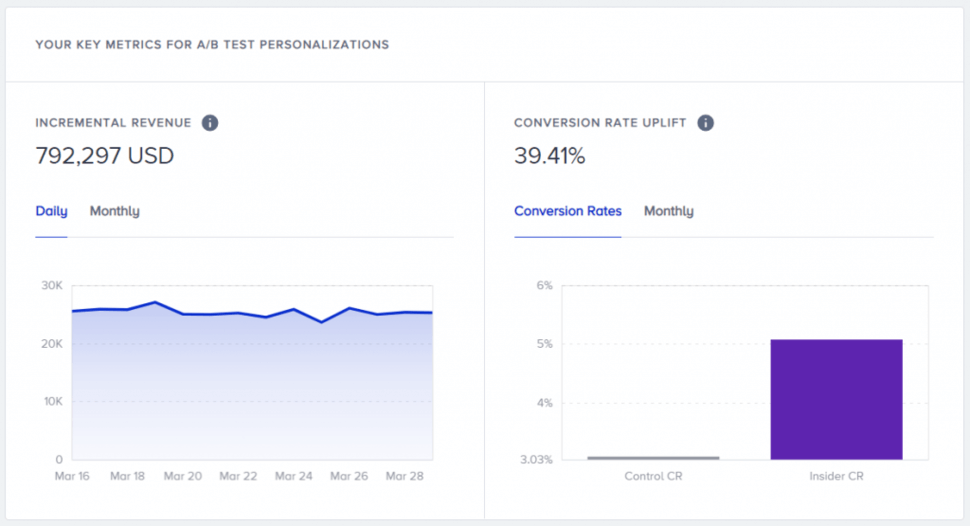
- Conversion Rate Uplift: This is the change (increase or decrease) in the personalized version’s conversion rate over the control group, and it usually displays a percentage. By tracking conversion rate uplift, marketers know how effectively their personalization strategy contributes to revenue.
- Average Order Value Uplift: This metric provides the net increase in the average order value of a test group against the control group. It is either a percentage or expressed in monetary value. In industries like eCommerce, it quantifies the personalization-led extra order values from the same set of customers.
- Significance: A campaign or personalization is said to have high significance (or statistical significance) if a particular personalization has shown visible effectiveness over its control group. This effectiveness usually measures a positive change in impressions or increased uplifts like conversions or average order value.
- Email ROI: Emails are still the most popular channel in B2B and one of the best bang-for-your-buck channels used by marketers, along with engagement metrics like open rates, conversion rates, CTR, and ROI-focused metrics like Click-Through-Revenue help to attribute revenue generated by email personalization campaigns.
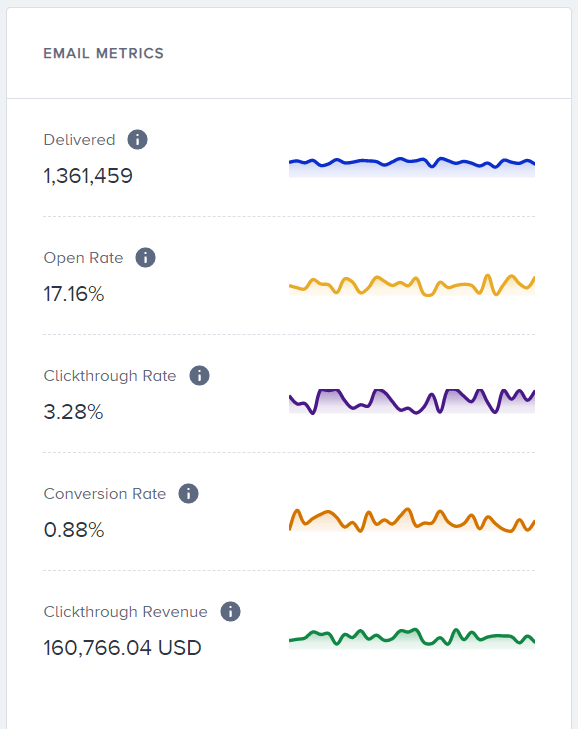
- Sales/revenue from clicks: This metric provides the total sales or revenue figures from your personalization campaigns and represents gross sales or revenue figures. Usually, both these metrics track sales or revenues that are the outcome of specific personalization efforts and attribute themselves to these changes’ effectiveness in creating direct sales and revenues.
- Web push ROI: This is one of the best performing channels for engaging with your opt-in subscribers. The most successful web push strategies revolve around one-to-one individualized messaging based on a customer’s needs and historical or predictive behaviors. Combined tracking of opt-in and engagement metrics helps measure the ROI of web push personalization campaigns.
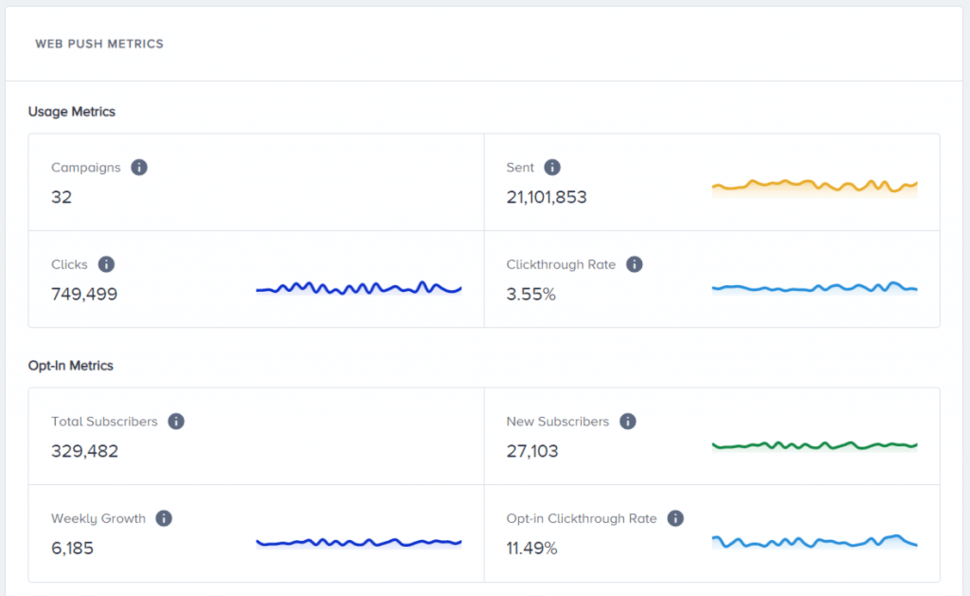
- Mobile app ROI metrics: Mobile apps are an essential part of an omnichannel marketing strategy. While you spend time and money building your app and getting downloads, it’s essential to understand and measure your mobile app’s performance to determine ROI. One of the core metrics is new user acquisition and recurring engagement on the app. By tracking the acquisition, engagement, and retention metrics, you can determine the success and ROI of your mobile app campaigns.
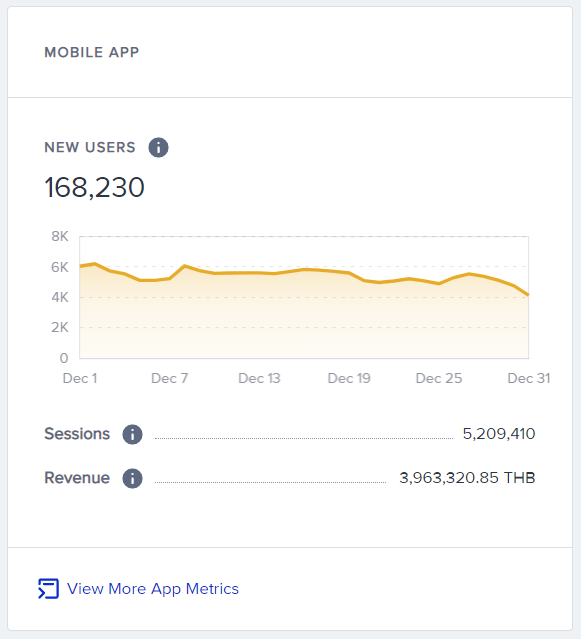
- Custom goal ROI metrics: Revenues, sales, conversion rates, and AOVs may not be the only goals that matter – especially in industries like commerce. Marketers may want to track their customers and micro conversion goals, like page views, product views, add to cart ratio, cart to sales ratio, and other custom-defined metrics. Success rate, uplift rate, and conversion tracking can easily measure the ROI of these custom goals.

How to use personalization ROI metrics
You now know what ROI metrics are essential to gauging personalization performance. These metrics may be straightforward, but they have to be used in the right way to optimize campaign performance. There are several ways in which marketers can excel at A/B personalization testing using these metrics. Let’s look at the three main use cases:
- Run unlimited personalizations: Every individual customer’s needs and requirements are different. That’s why one-to-one messaging for hyper-individualized experiences is the future of marketing. With the key ROI metrics tracked, marketers can now run as many personalization experiments, using multiple customer segments and still keeping track of their goals.
- Identify and optimize the winning campaigns: With the power of personalization ROI tracking, you can easily pick the best (or worst) performing campaigns. ROI tracking is especially critical for industries like retail and eCommerce, where thousands of personalization campaigns run simultaneously.
- Track channel-based personalization ROI: This metric helps marketers spot the most preferred channels to grow their customer base. For example, they can run web push personalizations for those segments who have responded positively to web push notifications.
Where to track personalization ROI?
Now that you’ve understood the key metrics to track and how to use them to optimize personalization strategies, the next logical question is how and where to find and track them. Insider’s product team spent long hours with its existing partners and customer success managers to develop an extensive dashboard to track all ROI-first personalization metrics in one single view.
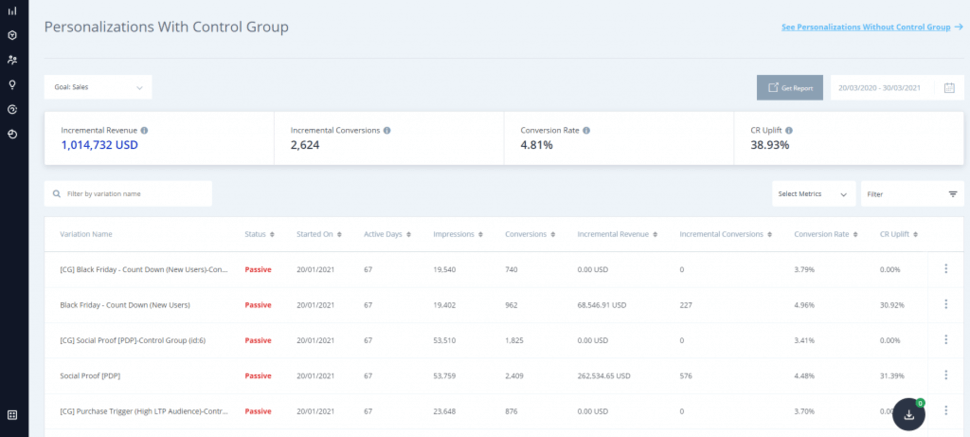
Read our product release blog to know more about the dashboard features. Request a demo of the Insider Growth Management Platform if you would like to kickstart ROI tracking for your personalization campaigns.



















